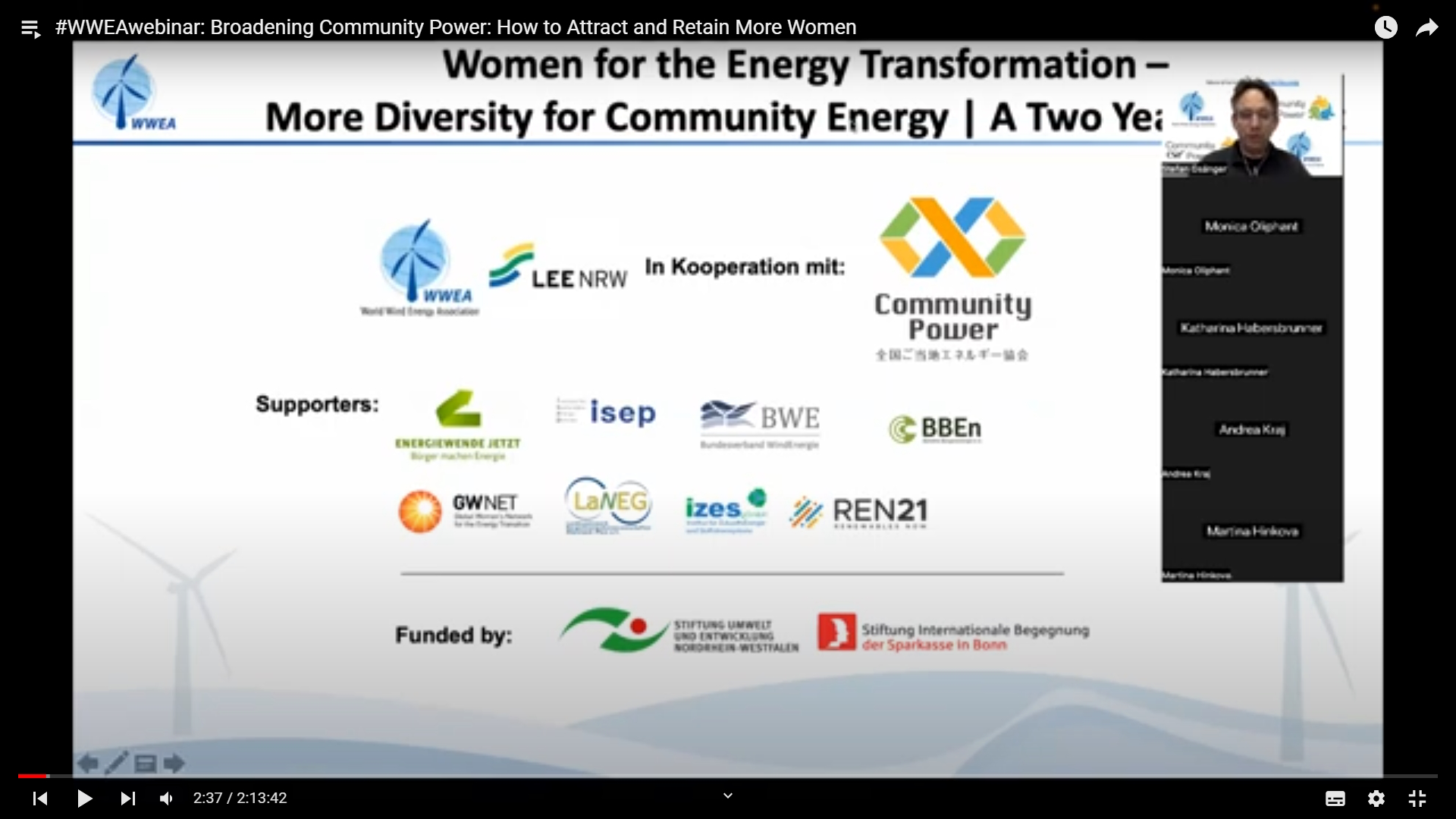In December 2022 the World Wind Energy Association held a webinar titled “Broadening Community Power: How to Attract and Retain More Women.” The event delved into the significant yet underexplored role of women in community energy, focusing on findings from a two-year research project conducted in Germany and Japan by the WWEA in collaboration with the Japan Community Power Network. This article summarizes the key points discussed during the webinar and the recommendations presented to foster a more inclusive and gender-balanced renewable energy sector.
The Importance of Community Energy
Community power, defined as locally owned and controlled renewable energy, is critical to harnessing the full potential of renewable resources globally. For community energy to be effective and sustainable, it must be inclusive, participatory, and democratic. Yet, the sector faces a significant gender gap. In Germany, for example, women represent only 29% of shareholders and hold 27% of shares in community energy projects. The situation is even more challenging in Japan, where women’s participation rates are lower.
The webinar highlighted that many women are unaware of community energy initiatives in their local areas—83% of women compared to 69% of men. Barriers such as lack of time, money, and information further hinder women’s participation. Despite these challenges, there is strong interest among women in contributing to the sector; 87% of women expressed interest in climate policies, 67% in energy policies, and 62% are interested in investing in community energy.
Strategies for Inclusion
To address these disparities, the research project concluded with several actionable recommendations. There is a need to broaden public understanding of community energy’s impact, create dynamic and inclusive participation opportunities, and reduce financial barriers to entry. Strengthening networks and alliances with local stakeholders, increasing gender-specific events, and enhancing social media outreach are also crucial.
The importance of citizen-oriented communication and positioning women visibly in leadership roles were emphasized. Improving the political framework for community energy is also necessary to ensure these initiatives are sustainable and inclusive.
Insights from Japan: Women in Solar Energy
The webinar also explored the unique positioning of women in Japan’s solar energy communities. Historically, Japanese women have been deeply connected to environmental and family welfare, which positions them positively towards renewable energy. However, a lag exists between their interest in solar energy and their active involvement or leadership in solar communities.
Japanese women’s employment patterns, often shaped by societal expectations, create additional challenges. For instance, women’s careers are frequently interrupted, making it difficult to achieve leadership roles. The study suggests that quotas could be a potential solution to improve gender balance in community energy. The positive role of peer-mentoring and creating an organizational culture that welcomes diverse perspectives and flexible participation were also highlighted as crucial steps forward.
The Global Perspective: Gender Barriers in Renewable Energy
The webinar also provided insights into gender barriers in the renewable energy sectors of Japan and Myanmar. In Japan, the renewable energy sector is relatively new, and while the number of women in community energy is growing, most managerial positions are still held by men. Encouraging face-to-face conversations to discuss working conditions and recognizing the unique perspectives women bring to the table were identified as essential strategies to improve women’s participation.
In Myanmar, cultural beliefs that engineering and technical fields are suitable only for men create significant barriers for women. Promoting female role models, improving educational opportunities for women in energy-related fields, and encouraging male managers to interact positively with female staff were suggested as ways to break down these barriers.
The Australian Experience: Women in Community Energy
Australia’s community energy sector offers a different perspective, where initiatives like Hepburn Wind and Denmark Community Wind have seen women take on key roles. However, challenges remain, especially in ensuring that community energy projects are promoted effectively and that a cohesive national plan is in place. The First Nations Clean Energy Network is a promising development, with a significant representation of women on its board, addressing the unique challenges faced by Indigenous communities.
Moving Forward: Empowering Women in the Energy Transition
The WWEA webinar underscored the need for systemic changes to empower women in the renewable energy sector. Gender barriers such as political inconsistency, lack of awareness, and entrenched social norms continue to hinder progress. However, the benefits of a more gender-inclusive approach are clear: stronger access to talent, enhanced innovation, and better compliance with stakeholder expectations.
Creating an enabling culture that supports the development of women leaders, encouraging flexible participation, and ensuring direct and personal communication within organizations are critical steps. Senior leaders must be accessible and committed to fostering an inclusive environment, and innovative communication methods should be employed to engage all participants.
In conclusion, the WWEA webinar highlighted the urgent need to address gender disparities in the renewable energy sector. By implementing the recommendations discussed, the sector can become more inclusive, driving both innovation and sustainability. As the global energy landscape continues to evolve, empowering women will be key to achieving a truly sustainable and equitable energy future.
You can view the webinar here: https://www.youtube.com/watch?v=9d-TSRljW08&list=PLiOCPPNkv_tBCyIv2bOymXrVCGJ35EqRL&index=4

